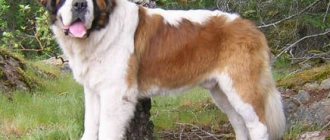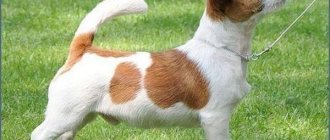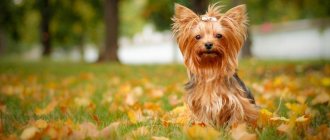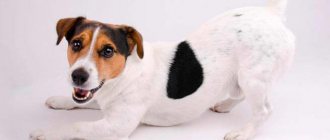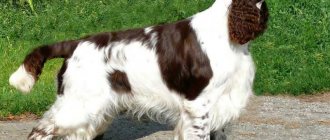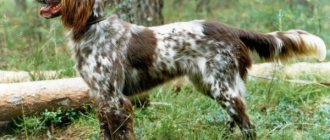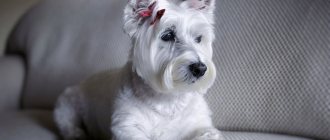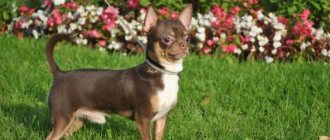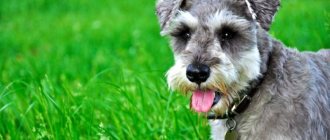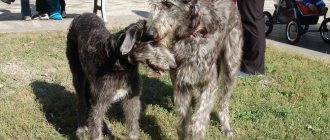- Pets
- >>
- Dog breeds
* Here is a photo of a typical representative of the Scotch Terrier dog breed . You can send us photos of your animals by email, and we will post them on the website. Don't forget to send your pet's name.
Other breed names:
Scottish Terrier
Video
* We invite you to watch a video about the Scotch Terrier . In fact, in front of you is a playlist in which you can select and watch any of 20 videos about a given dog breed by simply clicking on the button in the upper right corner of the window. In addition, the material contains quite a lot of photos. By looking at them you can find out what a Scotch Terrier looks like.
In this article:
|
Rate the material!
[Total votes: 0 Average: 0]
A dog that looks like a brush is a Scotch Terrier , also known as a Scottish Terrier, or Scottie. Smart, wayward, but loyal, and each dog has a bright personality. Always ready for work and defense, as evidenced by his brilliant, piercing eyes, protruding ears and perky upturned tail. The national breed of Scotland and a favorite of many dog lovers around the world.
Behavior and temperament
Scottish terriers have the following positive qualities:
- Calm;
- Endurance;
- Courage;
- Independence;
- Cheerfulness;
- Insightful mind.
Negative features:
- Intolerance, sometimes aggressiveness towards other animals;
- Stubbornness;
- At a young age - playfulness.
Scotties must be trained from childhood, otherwise they grow up to be aggressive and overly wayward.
History of the origin of Scotch Terriers
Once upon a time, among the mountains and valleys of the Scottish Highlands, the so-called mountain terriers arose - hunting dogs for catching and tracking small burrowing animals: rats, foxes, badgers. These dogs, with an elongated body, short strong legs and powerful jaws, did an excellent job of penetrating long holes and defeating the beast in one-on-one combat.
At least since the 16th century, such terriers became widely known in England, but at first they were considered a single group - Highland (highland) terriers. After much debate, which lasted throughout the first half of the 19th century and even later, it was recognized that the group was a national team. They began to divide it into several breeds, among which was the Scotch Terrier.
It was originally known in England as the Aberdeen Terrier due to its distribution in the area around Aberdeen, Scotland. It was called “Scottish” by Captain Gordon Murray, who wrote a description of the breed. He put an end to the debate about the “true” Scottie by achieving the adoption of a breed standard in 1880. The fact is that before this, other related terriers were often shown under the guise of Scotties: Skye, Dandie Dinmont, West Highland White or Cairn Terriers.
Interesting fact: The first Scotties arrived in America in 1883 and were registered by the AKC in 1885. Dogs gained popularity here, which peaked in the 30s and early 40s of the last century, when cult film actors Humphrey Bogart and Bette Davis appeared in public with their pets of this breed. But the main thing is that the country has seriously worked on the selection of Scotties and has obtained wonderful purebred lines.
Scotties appeared in Russia after the war and became objects of breeding at the state nursery “Red Star”. It cannot be said that they were rare during the Soviet period, but mass imports began only with perestroika. The breeding stock was enriched by imported producers and many breeders appeared. Russian Scotties win at international dog shows.
Scotch Terrier - description of the breed
A dense, short-legged dog, the size of which is suitable for burrow hunting. Height at withers 25 - 29 cm; weight 8.5-10.5 kg, without much difference between the sexes. Collected like a spring, very fast, despite the short legs. By nature she is courageous, very smart, restrained, and does not show aggression. It moves smoothly and freely, strictly protruding ears and tail reflect internal composure and readiness for action.
More details:
- The head is large relative to height. The skull is almost flat, relatively narrow. The transition from the forehead to the muzzle is little pronounced;
- Skull and muzzle of equal length. Cheekbones do not protrude. The nose is large. The jaws are long and strong. Scissor bite, large strong teeth;
- The eyes are oblong, brown, widely spaced, covered with eyebrows. The look is penetrating;
- The ears are erect, small and pointed, thin;
- The neck is muscular, of medium length;
- The back is straight, very muscular, including the lower back;
- The chest is wide, with rounded powerful ribs, smoothly rounded at the bottom and dropped low between the limbs;
- The tail is medium, proportional to the body, thick at the base. Set on high, standing upright or slightly curved over the back;
- The legs are straight, very strong, the ischial and femoral muscles of the hind limbs are especially powerful - the butt is round. Paws with collected toes, the front ones are slightly larger than the hind ones;
- The coat is about 5 cm long, dense, two-layered: with a soft undercoat and a hard, wire-like outer layer. Hair is straight or slightly wavy.
Deviations from the specified parameters are: weak muscles, crooked legs, imbalance of head proportions. The severity depends on the degree of impact on the animal's health. Large ears with wide bases are undesirable. Mental disorders (aggression, hysteria, etc.) lead to disqualification.
Appearance of the Scotch Terrier
General impressions
These small, shaggy dogs seem incapable of causing anything but joy and tenderness after the first glance. However, their short legs, overgrown with long, ragged hair, are able to cope with digging even in the most dense soil. And although the kids cannot boast of impressive size, they cannot be called short either. They grow up to 25-28 cm, and the weight of the Scotch Terrier reaches 10.5 kg, regardless of gender.
Head
The Scottie's skull is long and flat with a distinct, pronounced stop.
Despite the small size of the Scotch Terrier, the dog’s teeth are large and closed in a tight bite so that the upper row of incisors completely buries the lower one.
The nose is large, completely black, the line from the lobe to the chin is slightly sloping.
The eyes are set wide and almond-shaped. The iris is dark brown. The look is inquisitive, the eyes are slightly covered with massive eyebrows.
The ears are very thin, but erect and pointed.
Neck
The muscular neck is not too elongated.
Torso
The Scotch Terrier has an almost flat, short back. The chest is wide, voluminous, protruding forward and downward. This can be clearly seen in the photo of the Scottish Terrier in profile.
Forelegs
The front legs are short, clawed, and have straight pasterns.
Hind limbs
Hind legs with large, muscular thighs and short hocks. The pads on the paws are large and moderately hard.
Tail
The long, 16-18 cm tail is slightly thickened at the base, carried vertically, but a slight tilt is acceptable.
Movement
With their short legs, Scotch Terriers are able to overcome medium-distance forced marches. Their hefty endurance allows them to dig holes for an hour and a half after a 10 km run. And this is far from the limit of their abilities.
Wool
Scotties have a dense, short undercoat that lies close to the body. The outer hair is moderately long and dense. It reaches its greatest length on the stomach and sides, forming something like a “skirt”.
Color
The correct colors of the Scotch Terrier are black or wheaten in all its variants. Brindle color is also acceptable.
Size
Regardless of gender, Scotties grow up to 25-28 cm and reach 10.5 kg in weight. Excessive growth of a Scottish Terrier may be a reason for disqualification from exhibitions.
Popular Scottish Terrier colors
According to the standards, several colors are allowed, including variegated ones, which are very heterogeneous and difficult to classify. Motley areas can appear on evenly colored coats, which is not considered a defect.
Popular colors:
- Black color is considered the most common, but without reason. Dogs that are black, like beetle or anthracite, are actually rare. Usually those that appear black actually have patches of white, brown or gray fur;
- Wheat (fawn). A very fashionable color, known since 1905. In addition to the wheaten color itself, the red brindle is often included in it. They are best distinguished in newborns. Wheat - light, darkening with age. The fur of red brindles is unevenly colored: light at the base, red at the ends;
- Motley (brindle) - a mixture of various combinations of colors (red, brown, black and their lightened versions) and patterns.
There are:
- Brindle. All dogs of dark colors have the ancestral color of the breed, the brindle gene. The light background can be wheat, gray, or a shade of red. Stripes (tiger stripes) are black, gray, dark brown. The contrast can be either very bright or almost indistinguishable; such dogs are considered black;
- Wild colors: grizzly, badger, wild boar differ in background color and may have tan markings. For wild boar, the background is silvery, becoming lighter from the back to the belly. Badger background is fawn. Grizzly is a mixture of black and brown colors of varying degrees of lightening;
- Pepper and salt range from almost black to almost white.
With age, the dark brindle color may become covered with gray hairs - light hairs in certain places, for example, on the back. The color changes (blooms) for a number of reasons, including age, season, nutrition, etc.
Distinctive features
Dogs of this type must meet the requirements of the FCI standard, which provides the following parameters:
- The head has a flat skull of moderate width, not coarse. The stop is clearly visible. The muzzle is approximately equal in length to the skull. Cheekbones are poorly developed.
- The bite is scissors, although a straight bite is acceptable. The jaws are strong with large teeth.
- The nose is large and always black.
- The eyes are a rich dark brown shade. They are of medium size, not flat, but not convex either.
- The neck is strong, of normal length, and not “damp”.
- The ears are small in size, go up, and at the level of the skull line they bend down and straight. They should not “fly” when moving, they should lie tightly.
- The tail can be natural or docked to a third of its length. Usually raised, but not carried over the back.
- The body is approximately square in shape, with a strong and straight back, and a shortened lumbar area. The sternum is voluminous, with rounded ribs.
- The legs are straight, with developed bones and muscles. The angles of the knee joints and scapula are well defined. The hocks are not turned out and not high. The paws are small with dark claws.
- The coat of adult animals is soft, but not fluffy like that of a poodle, of medium length, covering the muzzle. It has a characteristic large curl or wave, and is devoid of undercoat (except for the inner area of the auricle). It is acceptable to exhibit dogs after trimming or in their natural state.
In the first case, the natural length of the fur is left above the eyes, in the area of the mustache and beard, on the limbs, and lightly removed along the body, emphasizing the silhouette. The neck, chest, skull and tail are cut short. The color allows all shades of wheat, the inside of the ear can be darker. The texture, length and color of the coat are finally formed at 18-24 months.
Character and habits of Scotch Terriers
Scotties are dogs with a strong personality. They are quite confident and quite independent for a dog. They can even be overly stubborn, in which they can compete with the owner. Fans of the breed call this terrier “unbending.”
Although the breed was bred to improve its decorative qualities, these dogs remain hunters by nature. They enthusiastically search for game wherever they are - in apartments and on city streets. And they immediately get down to business. Scotties are true enemies of walking cats and other small animals; pets are always at risk, and their fellow tribesmen irritate them.
The hunter's work style - efficient and businesslike - is transferred to other types of activities by the Scottie. They are not as fast as other terriers, but they are observant and able to analyze the situation. During a walk, the dog is usually busy with a thorough examination of the territory, without missing a single mark. But he will not refuse to play if he is offered.
It’s hard to expect, given their short legs, but the dogs are capable of very active games and long walks. They can compete successfully in some dog sports, especially agility. Hereditary qualities of a hunter: intelligence, agility, temperament allow these terriers to quickly overcome obstacles, defeating stronger but stupid opponents.
Interesting fact: Dogs are very smart and not just in appearance. They are superbly trained, despite their headstrong nature. The main thing is not to push. Scotty always knows when to give in to win. Praise, a treat, permission to walk longer - the dog doesn’t need much.
They are wary of strangers, not showing aggression, but not showing friendliness either. They are generally a reserved, self-sufficient breed, not prone to strong displays of emotions, affection, pestering, and do not bother with requests to play. Therefore they do not welcome small children.
Who is the dog suitable for?
The Scottish Terrier is a working, hunting breed . They are energetic, need regular walks and games, and need to be trained. Lovers of quiet leisure and elderly people should not get this breed. The dog is perfect for strict but fair owners who lead an active lifestyle.
It is worth considering that due to their short paws, Scotch dogs get tired from long walks and are not suitable for joint jogging.
Scottish Terriers are very loyal and obedient, but they are wary and distrustful of strangers. They are not prone to aggression, but they can show it if they sense danger.
They do not tolerate violations of personal boundaries , so it is not recommended to keep them in families with small children. The child will get along with the tape if he behaves calmly.
Scottish Terriers do not get along well with other pets if they are not accustomed to them. Therefore, it is advisable to accustom the puppy to them from childhood. Then, in adulthood, their relationship will be neutral (but it is important to ensure that the behavior of the other pet is unobtrusive). It is highly not recommended to keep a dog together with small animals or birds - it is better to keep them in cages.
Interesting facts about Scottish Terriers
It is impossible to imagine the famous circus clown of the Soviet era, Karandash (M.N. Rumyantsev), without his partner, the black Scotch terrier Klyaksa. That was the name of the artist’s first dog, and after it all the others that came to replace it. Pencil performed for 55 years, and Blots were 13. The latter outlived the owner.
The 32nd President of the United States, Franklin D. Roosevelt, was famous for many deeds, in particular for owning the Scottish Terrier Fala, which invariably accompanied him during the war. The dog is immortalized on the monument erected to the president at his Memorial in Washington. In addition to Fala, other Scottish terriers of the same Roosevelt and his wife lived in the White House. The 43rd President George W. Bush had two Scotches, and one of them, Barney, starred in nine films about the White House.
The English writer and poet R. Kipling kept Scottish terriers on his Batemans estate and even “edited” a story written by one of them. The fairytale story “Your humble servant the dog Boots” about the adventures of a dog is available to our readers. Those who are inclined to more serious matters can pay attention to fashionable bags from Radley - they bear the brand name: the Scottie silhouette. An echo of the American Depression era, when this image was the advertising leitmotif of textile sports design products.
Scotch has starred in many films: “The Adventures of Sherlock Holmes and Dr. Watson, the Bloody Inscription series,” where he plays the dog Lestrade. In “Guest from the Future,” one of the main characters, Fima, is walking with Bulka with scotch tape. There are episodes in “Escape” (France, 1978), in “Merry Stories” (1962), in “The Extraordinary Adventures of Adele” (France, 2010), in the TV series “Jeeves and Wooster”, where Scotch plays the role of Aunt Agatha’s dog .
Pros and cons of Scottish Terriers
The tough temper of dogs of this breed obliges them to be trained from an early age. But a well-mannered Scottie is a great friend and companion. Education restrains, first of all, his hunting impulses, which makes walks with him pleasant. The dog has funny habits and is interesting to watch when he thoughtfully and importantly studies the territory.
He is always ready to play ball if the owner pleases, or to have fun by following commands and training. Scotty loves to learn, as long as he is polite and encouraged. He meets pressure from the owner with appropriate resistance. This is a breed for reserved and patient people.
A dog can remain alone without damage to the psyche; it is completely self-sufficient. Doesn't require attention, doesn't make a fuss over trifles. Barks rarely, but expressively, as if communicating something. Scotch tape is well suited for people who love silence, a calm, measured life and are not too actively involved in a healthy lifestyle. They love to watch TV. You could say it's a pensioner's dog.
If you take into account his habits, for example, observing feeding times or the usual walking route, then Scotty will be cheerful and calm. Together with the owner, he easily adapts to new places and circumstances and is tolerant of weather conditions.
Interesting fact: A significant drawback of the Scottish Terrier can be considered its intolerance to frivolous, familiar attitudes, which children are guilty of. Scotty can't stand being cuddled, yelled at, or played with as a toy. They think that he is unfriendly with guests, but this is the cost of poor upbringing.
Having acquired such a terrier, you will have to respect his personality. This breed is not suitable for people with a sharp, categorical character, as well as for those who tend to rush around with a pet like a doll. It is not suitable for travelers who are forced to come into contact with many strangers.
Education and training
Scottish Terriers are as smart as they are stubborn. They do not take criticism at all, but they really love praise addressed to them. This will be useful for you to start learning. At first, the terrier will actively try to follow all your instructions, but over time, his enthusiasm will fade, the activities will become a routine for the dog, and he will try with all his might to switch to something more interesting. Therefore, raising and training a Scottish Terrier should turn into an exciting activity.
Scotties follow some commands with more enthusiasm than others. This is a manifestation of not the best trait of the breed - selectivity. They like active actions; even as a puppy, a terrier can easily master the commands “Look!” or “Fetch!”, but with the seemingly simple “Sit!” or “Lie down!” things are tight. You have to constantly concentrate their attention with the help of treats, because other methods of training do not work on these smart guys at all.
There is no universal training program for all Scottish Terriers: each dog has a unique character and habits. Classic methods are a waste of time, according to experienced breeders, so you have to act according to the situation. Try to combine play and study so as not to force your pet with boring exercises and not develop in him an aversion to exercise.
Try to conduct classes in a place with a minimum of distractions. If the dog is tired, the session will have to be interrupted. The Scottish Terrier is not one of those who will forcefully follow commands - he is too willful. There is no use going to the training ground with him. Too long monotonous actions will quickly exhaust the animal and after just a few trips he will completely refuse to follow commands.
From childhood, teach your Scottie to walk on a leash, because his hunting instincts are impossible to keep track of. You can start taking your puppy for walks as early as 2.5-3 months. Playful kids, despite their size and age, destroy everything they can reach. This is normal, so it's best to hide all expensive shoes, remove carpets from the floors and things that can be broken or chewed by small growing teeth.
Repairs should also be temporarily abandoned. Most likely, it will be needed when your terrier matures and stops acting like a little hurricane. As a last resort, you can always discourage the dog by lightly spanking him with a rag or newspaper. But this only works when the dog understands why he is being punished.
At a young age, Scots love to bite, but under no circumstances should this be left unattended, otherwise the habit will remain in adulthood. Do not yell at the puppy: he will definitely perceive this as an additional reason for offense.
Don’t expect your Scottish Terrier to learn at least one command from the very first training. Representatives of this breed think first and only then do something. And if your command seems meaningless to the dog, it is unlikely to obey. Don’t burden your puppy with countless repetitions of the same action; it’s better to dilute the activity with an exciting game.
Although this breed is a hunting breed, now almost no one uses small terriers for hunting. This is not due to a loss of instinct, but rather due to the owners’ reluctance to spend time on this. Mini-hunters have long turned into glamorous pocket dogs, which hardly anyone will allow to pick in the ground or run through the forests.
But if you don’t mind spoiling the appearance of your terrier, attend special dog training classes. In a month or two, this gentleman will be reminded of what his natural essence is, and now you have in your house a master in catching foxes and small animals.
Breeding Scotch Terriers
Despite the good study of the genetic combinations responsible for the colors of the Scottish Terrier, it is problematic to determine its hereditary potential by phenotype. This is due to the prevalence of variegated (Brindle) colors. Even outright black can turn out to be mottled upon careful inspection.
Genetic tests have been developed for this breed to determine the presence of all genes responsible for color, length and other characteristics of the coat. When choosing a pair, you can predict in advance the colors of the litter based on gene combinations. But there are known patterns. For example, white spots are passed on to the first generation 100%, even if only one of the parents had them.
Interesting fact: Wheaten Scotties are especially difficult to breed. This color is recessive and is suppressed by any other in the first generation. But if you breed two dogs with a wheaten color, excessive lightening will occur, including the noses, which will turn pink. And this is not allowed by the standard.
As for the exterior, it requires the eye of an experienced breed connoisseur. Simply selecting “the best” may not give the desired result. On the contrary, it can lead to a combination of common defects in the unfortunate offspring. It is not for nothing that they believe that breeding requires talent.
You don't need talent to avoid inherited diseases. Even those that do not manifest themselves phenotypically. Both serious Scotch problems - craniomandibular osteopathy and von Willebrand disease - can be identified by testing and carriers can be immediately excluded from breeding.
Pregnancy, which lasts for (58)60 – 62(72) days, and birth in the Scottish Terrier is the same as in most small dogs. Bitches are allowed to breed from 20 months of age, and males from 24 months of age. A litter usually contains from 1 to 6 puppies.
Childbirth in a dog
Puberty begins with the dog's first heat. Scotties first shed hair, like most other breeds, at six to eight months. There is no need to breed your dog right away. The optimal age for females is 18-24 months, for males - 2 years. Mating is carried out twice on days 12-14 of the cycle.
Pregnancy lasts 60-64 days. The cubs may be born a couple of days earlier or later - on the 72nd day. Childbirth can be difficult due to the large puppies and the small size of the mother. If your dog will require a caesarean section, you should have a trusted veterinarian at your disposal. There can be up to eight puppies in a litter.
To carry out labor activities, you must obtain permission from the club. Future parents must be completely healthy, vaccinated, and have no deviations from the standard or chronic diseases.
Scotch Terrier Care
The peculiar appearance of dogs of this breed is the result of grooming.
To care for the coat, you will need to use several techniques:
- Plucking (trimming). It consists of removing dying guard hair on the upper side of the body from the back of the head to the tail, on the sides and on the tail itself. The remaining fur should not exceed 5 cm in length. This is done by hand or with a special tool. At the same time, comb out the undercoat with a stiff comb and pluck the undercoat with your hands. They do this twice a year, during the molting period;
- Haircut with a machine. The tops of the ears are trimmed so that areas with terry remain below. The forehead and above the eyes are trimmed, leaving bushy eyebrows. The fur on the neck and upper chest is greatly shortened;
- Decoration with scissors. Comb and trim with scissors the long hair on the face (eyebrows, mustache, beard) and the lower part of the body, where it forms a “skirt”, from under which only the fingers are visible. The fur on the sides should flow naturally into the skirt without a sharp border. The tail is trimmed so that it tapers like a carrot.
It is not recommended to cut the back and sides with a clipper; over time, this will lead to a change in the quality of the coat, which will almost permanently lose coarse hair. In addition, shaved bristles can irritate your dog. To make life easier for yourself and the dog, you can simply cut off the skirt and other braids.
The dog is combed weekly with a comb or slicker to prevent tangles from forming. In rainy weather, the pet is taken out in overalls, so as not to bother with washing the skirt later. It’s enough that after eating he often has to wash his beard. Show dogs are washed once a month, and wheaten dogs are treated with a whitening shampoo.
Common procedures include trimming nails as needed and ears once a week. Puppies are taught to perform hygiene procedures early so that they consider it a necessary evil. Trimming begins this way at 4 months.
Features of feeding and diet
Terriers are extremely selective in food. Particular attention should be paid to meat. Under no circumstances should Scotties be fed pork or lamb - this has an extremely adverse effect on their liver and in 100% of cases causes diarrhea. But raw beef is an excellent choice.
If desired, it can be replaced with boiled offal, but not more than three times a week. Raw skinless chicken or turkey can also be a nice addition.
Once every 1-2 weeks you can pamper your dog with boiled sea fish fillet. The daily menu must include low-fat cottage cheese or cheese. Garnish: buckwheat or oatmeal porridge with carrots and chopped raw cucumber. Sometimes you can diversify the menu by replacing any of the cereals with rice. Every other day, add a little bone meal (but never whole bones) or feed from a pet store to your dog's food.
Dry food should be chosen at least super-premium class. With this diet, no additional additives or feeding are required.
The serving size depends on the activity of the dog. If your baby has lost weight, increase the portion slightly. Well, if you start spending more time on the couch, cut it down.
Scotch Terrier diet
If the Scottish Terrier's coat is healthy and shiny, there is no irritation or dandruff on the skin, and the stool is normal, then the diet can be considered balanced. Regardless of whether the dog eats ready-made food or natural food.
Small cubs aged 3 - 4 months are fed 5 times a day, from 4 to 6 months they are given food 4 times a day, adolescents from six months to one and a half years - 3 times a day, in the future two feedings will be enough for adult dogs. Uneaten food is taken away so that the dog clearly knows the time of lunch, but water must be freely available at all times.
Meat and offal, mainly beef, predominate in the diet. Rabbit, chicken, horse meat, and lamb are also recommended, not necessarily of the highest quality. It’s even better if the meat contains tendons, ligaments, and cartilage. Raw meat is considered healthier, but you can also cook it. The bones are always given raw. It is believed that boiled ones break more easily into dangerous sharp fragments.
Interesting fact: Beef tripe is very useful - a source of microelements, vitamins and microorganisms necessary for digestion. Additional sources of animal protein are fish (raw), low-fat dairy or fermented milk products, eggs. It is better to exclude fat and animal oil from the diet.
Breeders have different attitudes towards porridge, some believe that they are necessary, some recommend leaning on vegetables. Porridge is more economical. Buckwheat, rice, millet, and rolled oats are optimal. By the way, ready-made food always contains grains, including corn. That is, professional nutritionists do not doubt their necessity.
Vegetables and berries that will be useful:
- Carrot;
- Tomatoes;
- Cucumbers;
- Pumpkin (zucchini and pumpkin itself);
- Greenery.
Content Features
Due to its small size and pronounced aristocracy, the Scotch Terrier is perfect for keeping even in a small apartment. Shedding is moderate, regular combing and timely trimming reduces the amount of fur scattered around the apartment. There will be no dog smell from your dog if you bathe it regularly. In some kennels, Scottish terriers are kept in enclosures, but owners who are making a friend and companion rarely welcome year-round keeping in a limited area and try to give them more freedom. Scottish Terriers that are cooped up most of the time require more attention and when they don't get it, they become lethargic and unhappy. When keeping it, it should be taken into account that the modern Scotch Terrier has retained its hunting instincts and passion for digging.
At home, Scotch must have a personal area where there will be a sleeping place with toys, as well as a corner with bowls.
The Scottish Terrier is a very active, energetic dog that needs moderate physical activity. It is advisable to provide the dog with a double walk, and the evening walk should last at least half an hour and be filled with games and activities. Scotchies are not athletic enough to withstand jogging or long hikes, so they are a good choice for couch potatoes.
You should not let go of the leash while walking through meadows and forests if there is a possibility that there is game walking there - upon smelling the scent of the animal, an aristocratic Scot turns into a tramp and onlooker. Only an adult dog can be walked freely in a safe place, provided that it always returns on command and never fights.
Care
To maintain the beautiful appearance of the Scottish Terrier, you will have to make some efforts. The dog does not require daily brushing and, in general, caring for it is not difficult, but it must be done regularly, using high-quality cosmetics. For Scots, you need to use a nourishing shampoo, and not one designed for coarse coats - it dries out the hair greatly, as a result, the beard and skirt become sparse and brittle. Lather and rinse the shampoo with water 2 times, then rub the conditioner into the skirt, beard and paws. Before drying with a hairdryer, rub a cream conditioner into the wet wool, which does not require rinsing. After drying, the wool is combed first with a brush and then with a wide-tooth comb. When detected, tangles are combed out with a tangle cutter. After making sure that the dog is well combed, it is allowed to dry in the open air. Until the next wash, which will be in 2 weeks, the coat is not combed. It is not recommended to wash the Scottish Terrier before a show.
Before the show, it is better to use a spray shampoo that does not need to be washed off - it will maintain the correct structure of the hard coat.
It is recommended to trim wool according to the principle of regular plucking and combing. The frequency of procedures is determined individually - some dogs have to remove protruding hair once a week, others once every 2-3 weeks. Owners who do not show their dog often resort to trimming its beautiful coat, which undoubtedly spoils its structure and the appearance of the dog as a whole, but makes grooming easier.
Eyes and ears are cleaned as necessary, the length of the claws is monitored and, if necessary, trimmed to the optimal length. The Scottish Terrier's ears stand up at about 3 months. During the period of teeth change, some dogs' cartilage weakens, which delays the process of installing the auricle for up to 7 months.
Nutrition
A dog's health largely depends on proper nutrition. In the case of the Scottish Terrier, a complete diet can be provided with both natural products and high-quality ready-made super=premium or holistic class food. At first, the puppy is fed the same food that he ate from the breeder. As your baby gets older, you can gradually switch your baby to a different diet.
Scottish Terriers are prone to gaining excess weight, so it is important not to overfeed the dog and monitor his body composition.
Diseases and health problems
Scottish terriers have a number of specific diseases, including hereditary ones. In addition, many breeds can develop eye problems as they age, such as cataracts and glaucoma. Skin diseases, scabies is more common, are caused by parasites (subcutaneous mites) or allergies. Dogs typically live between 11 and 13 years. Certain types of cancer are much more common in this breed than others.
Scotties are especially susceptible to 6 types of this disease:
- Bladder cancer and other lower urinary tract carcinomas. Typically found in older females;
- Malignant melanoma;
- Stomach cancer;
- Squamous cell skin cancer;
- Lymphosarcoma;
- Nose cancer.
Scotty Crump is an autosomal recessive inherited disorder that causes spasmodic paw movements, poor coordination, and the inability to walk. Aggravated by stress. Caused by disruption of biochemical processes in the nervous system.
Craniomandibular osteopathy is inherited in an autosomal recessive manner. In puppies aged 4-8 months, spongy bone tissue of parts of the skull begins to grow (jaws, occipital bones, tympanic bladder) and replace lamellar bone tissue with it. This causes thickening of the bones, including the jaws. The dog has difficulty eating and is in pain. The disease stops after reaching a year, but leaves side problems. Detected in a genetic test.
Von Willebrand disease (pseudohemophilia) is a hereditary blood disorder that also occurs in humans. It manifests itself in poor blood clotting, bleeding from the nose and other mucous membranes, and severe blood loss after injury. Detected by genetic testing.
Cerebellar abiotrophy is a congenital hereditary disease of an autosomal recessive type. It manifests itself immediately after birth in disturbances in spatial sensation, uncoordinated movements, loss of balance, and trembling.

